Retro Review: Fantastic, August and October, 1972
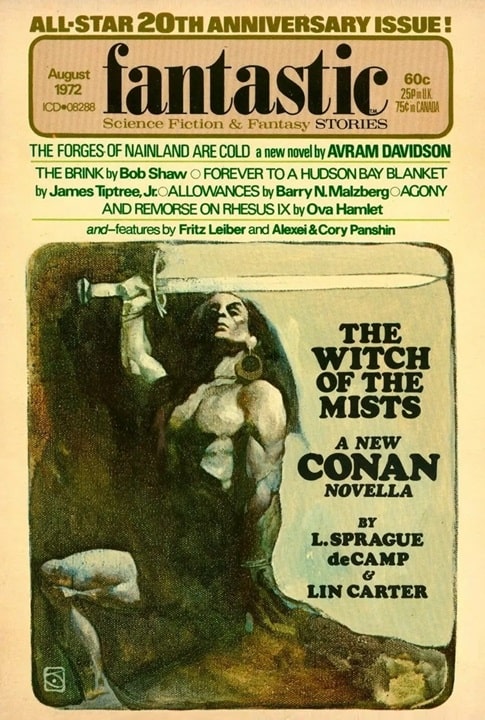 |
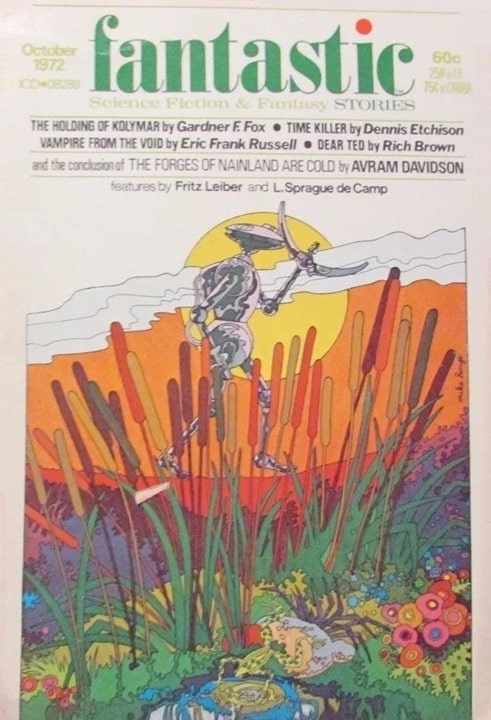 |
Fantastic magazine, edited by Ted White. August and
October 1972. Covers by Jeff Jones and Mike Hinge
My Retro Reviews of Amazing have concentrated on the Goldsmith/Lalli years, but I recently read this pair of issues from Ted White’s era, which extended from 1969 to 1979. As a youngster, I started reading Amazing in late 1974, so right in the middle of White’s editorship.
These two issues, then, date a bit earlier than my first encounter with Amazing. I bought them so I could compare the serialized version of Avram Davidson’s Ursus of Ultima Thule with the book version. But there was plenty more of interest in these two magazines.
TOCs first.
August 1972
Serial
“The Forges of Nainland are Cold,” part 1 of 2, by Avram Davidson (14,000 words)
Novelet
“The Witch of the Mist,” by L. Sprague de Camp and Lin Carter (title erroneously given as “The Witches of the Mist” on the TOC) (11,400 words)
Short Stories
“Forever to a Hudson Bay Blanket,” by James Tiptree, Jr. (6,600 words)
“Allowances,” by Barry N. Malzberg (erroneously identified as Barry M. Malzberg on the TOC) (3,300 words)
“The Brink,” by Bob Shaw (1,800)
“Agony and Remorse on Rhesus IX,” by “Ova Hamlet” (Richard A. Lupoff) (title erroneously given as “Agony and Remorse of Rhesus IX”) (3,100 words)
Features
“Editorial,” by Ted White
“SF in Dimension (Mastery of Space and Time — 1926-1935),” by Alexei and Cory Panshin
“Fantasy Books,” by Fritz Leiber
“According to You” (letter column)
October 1972
Serial
“The Forges of Nainland are Cold,” part 2 of 2, by Avram Davidson (15,000 words)
Novelet
“The Holding of Kolymar,” by Gardner F. Fox (6,700 words)
“Vampire from the Void,” by Eric Frank Russell (9,000 words)
Short Stories
“Time Killer,” by Dennis Etchison (4,400 words)
“Dear Ted,” by Rich Brown (3,500 words)
Features
“Editorial,” by Ted White
“Literary Swordsmen and Sorcerers (Sierran Shaman),” by L. Sprague de Camp
“Fantasy Books,” by Fritz Leiber
“According to You” (letter column)
I have various things unrelated to the fiction to mention. First — the covers. The first was signed by Jeff Jones, who later changed her name to Jeffrey Catherine Jones. (She may have been the first trans person I was aware of.) The second is by Mike Hinge, a New Zealand based artist who was strikingly original and very cool, and did a lot of work for Ted White’s magazines. Interiors were by Mike Kaluta, Roland, Joe Staton, Billy Graham, and Dave Cockrum (pretty much the same crew for each issue.)
Second — font size. The August issue had a significantly smaller size, so about 500 words per page, versus 440 in October. (The features were always the smaller font.) I find that kind of interesting, and I’m surprised publisher Sol Cohen let White do that.
The features always included chatty and sometimes controversial editorials by Ted White. August was uncontroversial — this was Fantastic‘s 20th Anniversary issue, and he discussed the history of the magazine. In October he responded to various comments he had made complaining about how Worldcons were run. Ted knew whereof he spoke, to be sure, having been the co-chair of NYcon 3 in 1967.
The letter column was also intended to be a forum for conversation, and much of it was devoted to responses to the editorials, or to other letters. Writers in August included Michael Main, Michael R. Ball, W. E. Smith, Bert Furioli, Mark Stephenson, Ed Lembacher, Charles T. Smith, Ed Sinkovits, and Bob Siemer. In October, Dennis O’Neil, Maggie Thompson, Joe Farara, Lester G. Boutillier, Glen Sadler, Darrell Schweitzer, and Erwin S. Strauss. Of those names, Michael Main (who compiles lists of time travel stories to this day), Darrell Schweitzer (who was by about a decade later an assistant editor at Fantastic), and Erwin S. Strauss (still a regular at conventions, known to most as Filthy Pierre) are familiar to me.
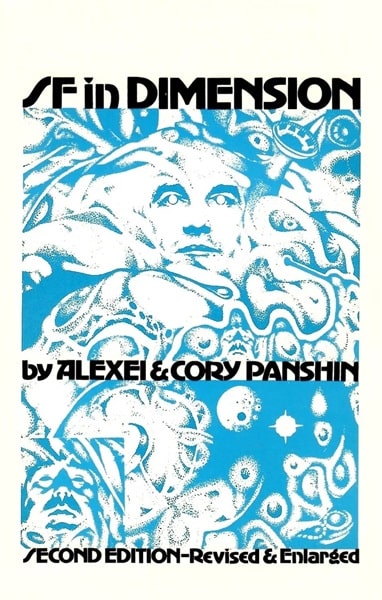 |
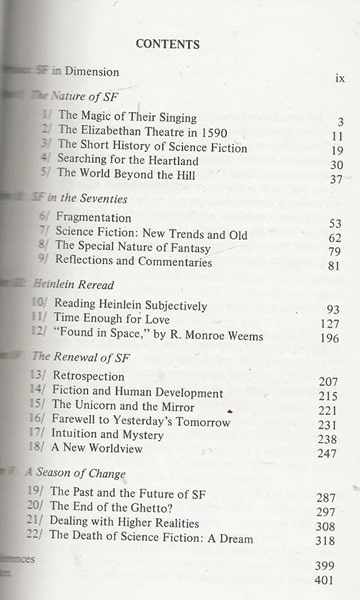 |
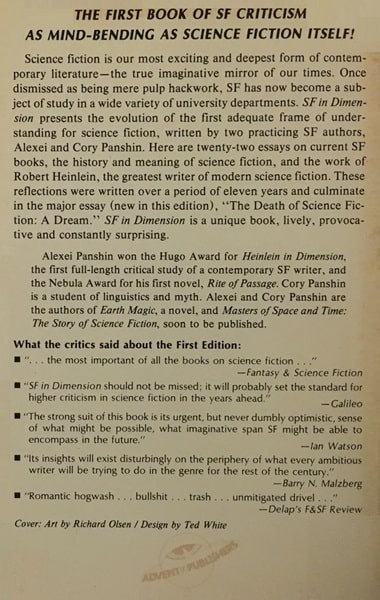 |
SF in Dimension, Second Edition, by Alexei and Cory Panshin
(Advent: Publishers, September 1980). Cover by Richard Olsen
The other features are perhaps more significant in a way. In August, the essay by the Panshins was, as the title hints, part of their eventual massive book SF in Dimension. (Essays that, significantly revised, I believe, became part of SF in Dimension had been appearing in Fantastic since 1970.) This one covers the years from 1926 to 1935, and discusses the space opera of E. E. Smith and John W. Campbell; the Sword and Sorcery of Robert E. Howard and Clark Ashton Smith, and the brief career of Stanley G. Weinbaum. On the whole I think the Panshins are far kinder to most of this work than I’d be.
As for Clark Ashton Smith, he is the subject of L. Sprague de Camp’s essay in October, “Sierran Shaman.” As with the Panshins’ essays, de Camp’s series Literary Swordsmen and Sorcerers appeared in Fantastic over several years, and eventually became a book with that title. I will confess that I am not terribly versed in the work of C. A. Smith, and I am willing to take the advice of the Panshins and de Camp (and others) and give him a more extended try.
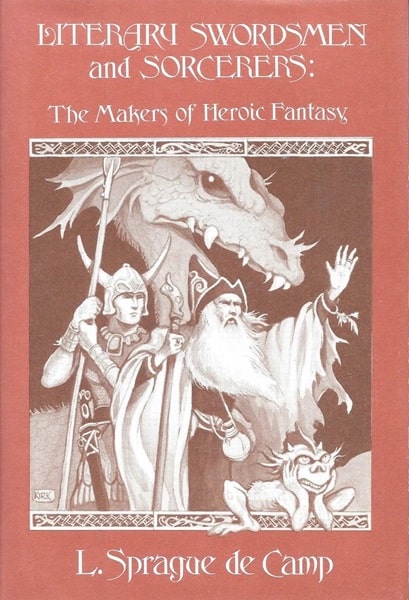 |
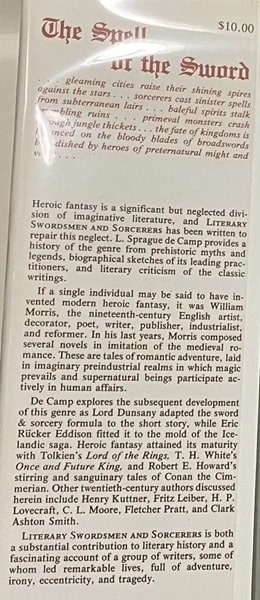 |
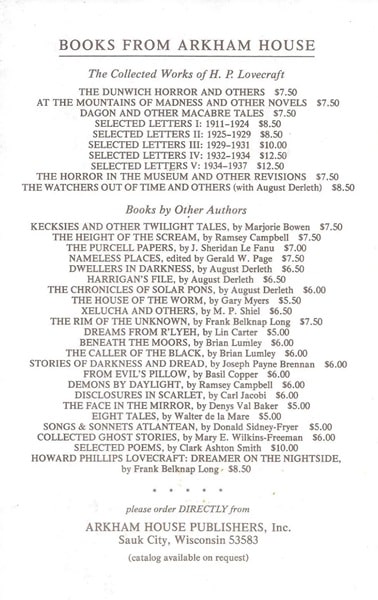 |
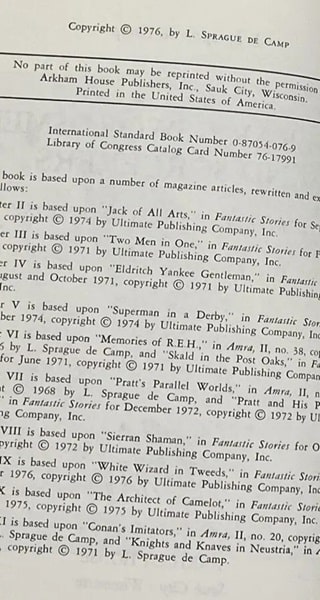 |
Literary Swordsmen and Sorcerers by L. Sprague de Camp
(Arkham House, 1976). Cover by Tim Kirk
The last feature is the book reviews, Fantasy Books, done by Fritz Leiber. In October he discusses Lin Carter’s book on Lovecraft, C. S. Lewis’ Narnia books, Poul Anderson’s Tau Zero, Anthony Burgess’ A Clockwork Orange, and Asimov’s Guide to Shakespeare. In each case he is sensible and generally approving.
The August reviews are more interesting because they’re a bit more unconventional. He reviews Heinlein’s I Will Fear No Evil, somewhat more positively than most reviewers have been, though with significant reservations, and he places it among a group of novels he calls “flawed masterworks,” with Stranger in a Strange Land, The Moon is a Harsh Mistress, and the much earlier Beyond This Horizon.
Lovecraft: A Look Behind the Cthulhu Mythos, by Lin Carter
(Ballantine Books, February 1972). Cover by Gervasio Gallardo
Also interesting is his list of books he rereads, which (not counting those outside the field) include Wells, Stapledon, Delaney, Sturgeon, Bring the Jubilee, Watch the Northwind Rise, Catscradle, The 25th Hour, 1984 — and lots of Heinlein, but especially Double Star, Spaceman Jones, and Time for the Stars.
In the preceding I have included Leiber’s mistakes — which I really think are Ted White’s fault — an editor should correct errors like “Delaney,” Catscradle, Northwind, and most especially Spaceman Jones instead of Starman Jones. (Later, Leiber cites Doorway into Summer instead of A Door into Summer (and in the process misspells “Jennie” as “Jenny” in the title of Robert Nathan’s wonderful Portrait of Jennie)!) Leiber also discusses Lin Carter’s anthology New Worlds for Old, mostly praising it but taking Carter to task for his misunderstanding of Eddison; and a book of poems by Donald Fryer.
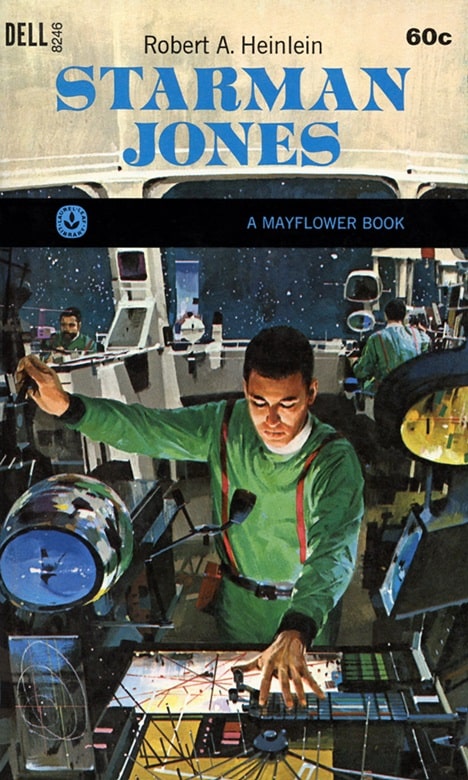 |
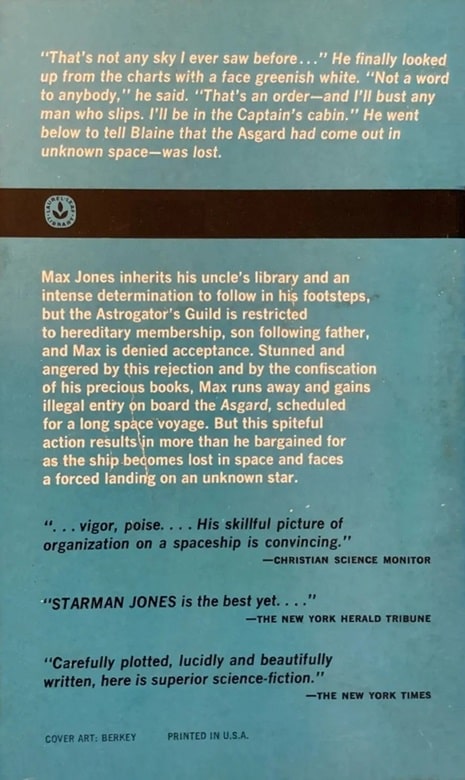 |
Starman Jones by Robert A. Heinlein
(Mayflower/Dell, April 1968). Cover by John Berkey
Now — at last! — the fiction. Let’s start with the serial, Avram Davidson’s “The Forges of Nainland are Cold.” As Ted White indicates in the introductory blurb to the serial, this is a sequel to his novella from the August 1971 If, “Arnten of Ultima Thule,” and the two stories together were to be published by Avon as Ursus of Ultima Thule. And indeed Avon published the novel as promised, including several thousand words of additional material in the form of a chapter interpolated between the two already published parts.
Though Fantastic calls this serial a “complete novel,” it is really a novella, about the same length as the story from If. It’s minor Davidson, enjoyable enough, telling of the destiny of Arnten, son of a sort of were-bear, in the ancient land of Ultima Thule, as he rises from abused boy in a village to exile, and then finding his father, and finally becoming the hero who cures the iron of its mysterious sickness. There’s a lot to enjoy in this story, but it doesn’t fully work. I wrote a fuller review at my blog, here.
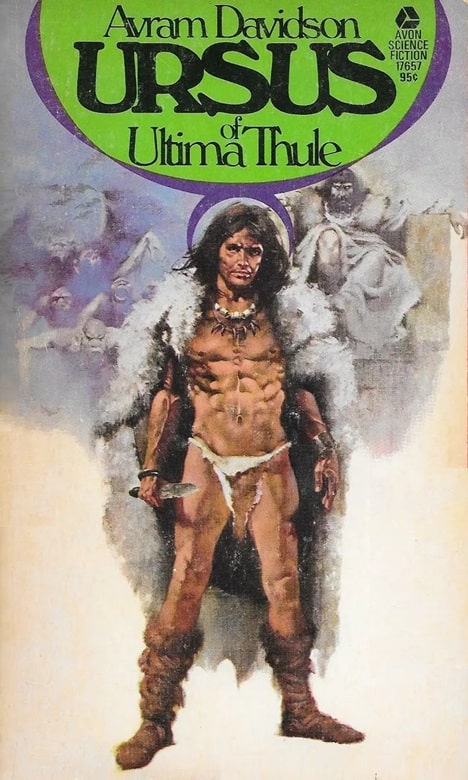 |
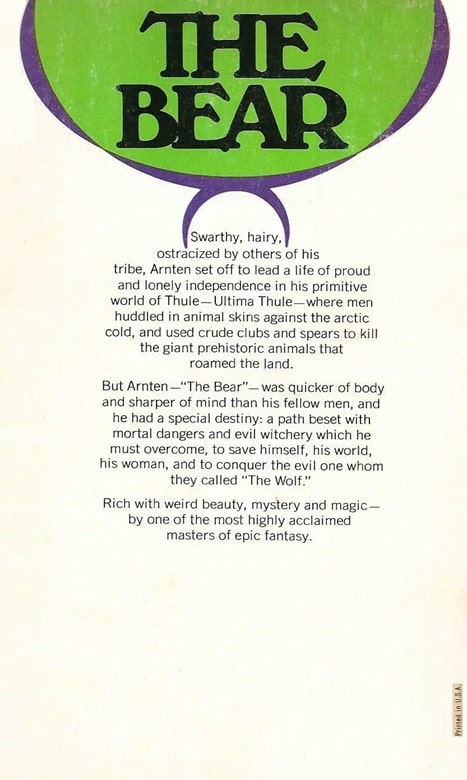 |
Ursus of Ultima Thule by Avram Davidson
(Avon, December 1973). Cover by Enric
Each issue also features a long standalone piece. The August story is “The Witch of the Mist,” by de Camp and Lin Carter, one of their “new” Conan stories. The authors had done a number of posthumous “collaborations” with Howard, in which they took fragments Howard had left behind and finished them. This story, however, is not based directly on anything Howard wrote — it’s a sort of sequel to the existing Conan stories, set late in Conan’s life, and featuring his son Conn as a major character.
In this case, Conn, showing his adolescent foolishness, has chased a mysterious white stag that transforms to a woman, in the company of some faceless men. Conn is captured and taken to the woman’s castle, and of course Conan pursues them. The action is — not terrible, but not great, roping in in a sort of virtual sense the evil Thoth-Amon. My bigger problem with the story is the prose, which is at best undistinguished (it’s tempting to blame Carter, because de Camp was capable of much better, but who knows?) and with the characterization of Conan, which is flat and lifeless.
In October, this is Eric Frank Russell’s “Vampire from the Void,” which Fantastic claims is a “new novelet.” It was not new. It was first printed in 1939 in the second issue of Fantasy, a British pulp which was the second attempt at a UK SF magazine aimed at adults. Alas, that magazine lasted only one more issue (wartime paper rationing was a big reason.) To be fair to Fantastic, the story had not been reprinted in the 33 intervening years, and as Fantasy was likely nearly completely unknown in the US, this story was doubtless unfamiliar to 99.9% of their readership.
It’s not a great story, by any means, but it’s competently executed, as one might expect from Russell, about a spate of mysterious disappearances in Liverpool (clearly some time in the ’30s), that move around weirdly. The story is more SF than fantasy, with the cause being a sort of strange alien that takes over its victims (humans, birds, cats) with the goal of spreading itself more and more widely. The solution to the problem is unimpressive, but Russell’s telling, and his somewhat cynical characters, make it a readable piece.
The other story listed as a novelet is “The Holding of Kolymar,” by Gardner F. Fox. It’s short of official novelet lengthy by my count, but who knows, my counts are just estimates. Fox is a writer who had a significant reputation in comics, and I’m willing to believe his work there was excellent — I’ve not seen any of it. But I’ve never much liked any of the prose fiction I’ve read from him — one novel and a few stories from the pulps. This story — pretty much his last short fiction (though there was a short serial in a gaming magazine a bit later) is not all that good, but it’s — acceptable? Conmoral is a retired general, summoned to defend his realm from the invading Rharm. In the process he brings the sorceress Queen Kyrce back to life — even though they had parted bitterly long past, when she turned evil. And they work to save their realm — after which Kyrce offers him the immortality she has gained. The ending is precisely the one we expect, but it’s all well enough executed.
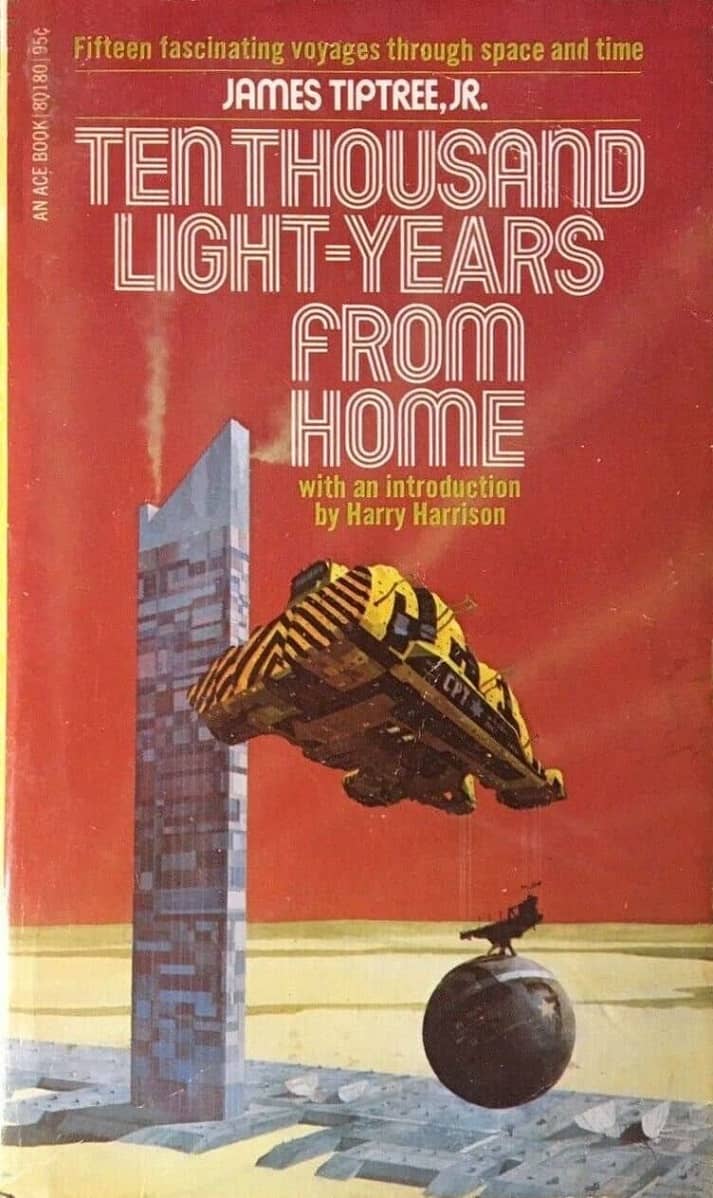 |
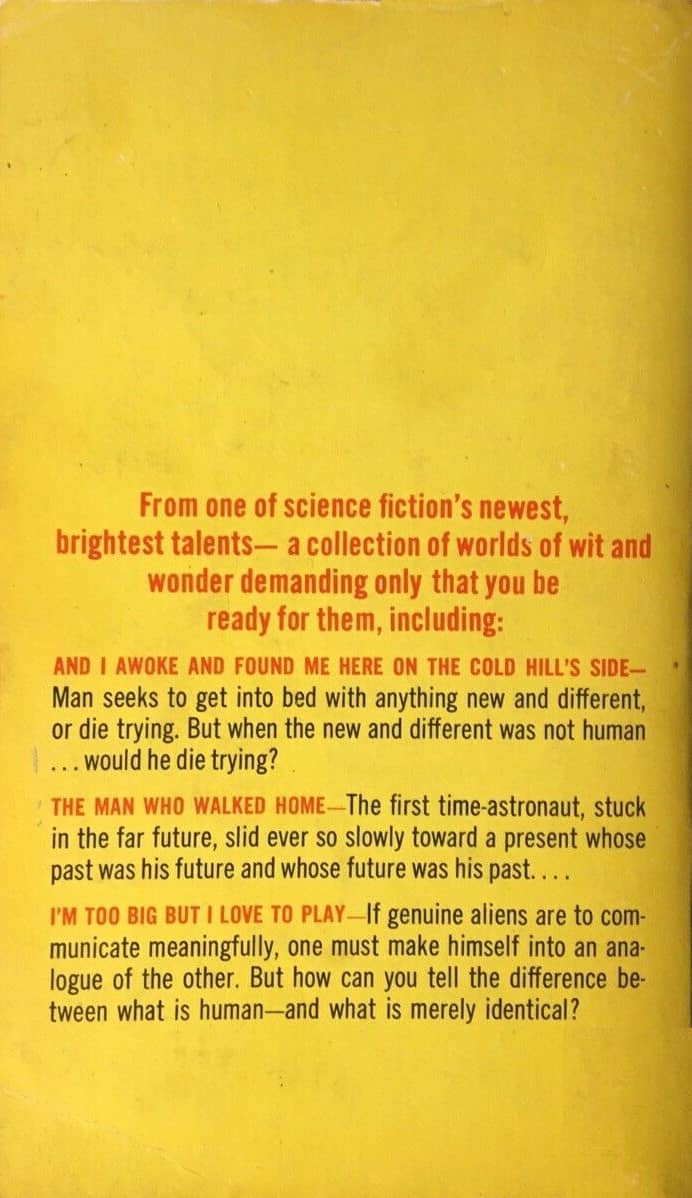 |
Ten Thousand Light-Years From Home
by James Tiptree, Jr. (Ace Books, 1973). Cover by Chris Foss
There are four short stories in the August issue, and they are a pretty good bunch all in all. “Forever to a Hudson Bay Blanket” is not one of Tiptree’s better known stories, but it’s one I loved on first reading some 50 years ago, in her first collection, Ten Thousand Light-Years From Home. Dov Rapelle is a wealthy young man in 21st Century Canada, who is in a cabin in the Alberta back country when a naked 16 year old girl comes stumbling through the snow. Of course he rescues her, and shortly later she is forcing herself upon him … which means angry relatives are soon involved.
I won’t detail any more, but there is time travel involved, and weird parental protection of young girls, and, well, like many many Tiptree stories, it’s about death and sex. And it’s deeply romantic. Also a bit creepy, which might have escaped my 14 year old mind. (Hey, at 14 sex with a pretty and willing 16 year old girl seemed — well, unlikely but not unwelcome.) Tiptree reused some of the time travel/sex plot in a very late novella, “Backward, Turn Backward,” which I found unpleasantly creepy. (Neither story has appeared in any of the big retrospective Tiptree collections.)
“Allowances” is an amusing if minor Malzberg story, telling of an alien desperately trying to win at the racetrack and always failing — with the destruction of Earth apparently a result. “The Brink” is a bitter story about a man delivering a horrible weapon to a future war zone, and in the process encountering something … mythological. And “Agony and Remorse on Rhesus IX” is one of some ten or twelve pastiches Richard Lupoff did, mostly as by “Ova Hamlet,” of various writers. This one takes on Philip K. Dick in telling of a functionary at a company on the all but uninhabitable title planet, who is struggling at his job, and hates his boss, who has stolen his mistress. The “hero”, of course, inevitably and comically fails.
The two short stories in the October issue didn’t work as well for me as well as the August ones. Dennis Etchison’s “Time Killer” is a wild story about a man obsessed with time — with clocks — who is (it seemed) determined to kill as many people involved with clocks as he can. Or maybe not? I confess I didn’t quite get it. Rich Brown’s “Dear Ted” is presented as a letter to Ted White, telling him why he can’t keep sending any more of the great stories he has — it’s because they weren’t his stories, they were sent to him mistakenly from a writer decades before… and they’ve stopped coming. Minor, mildly amusing if hardly original.
Rich Horton’s last article for us was a tripartite obituary for Terry Bisson, Howard Waldrop, and Tom Purdom. His website is Strange at Ecbatan. Rich has written over 200 articles for Black Gate, see them all here.
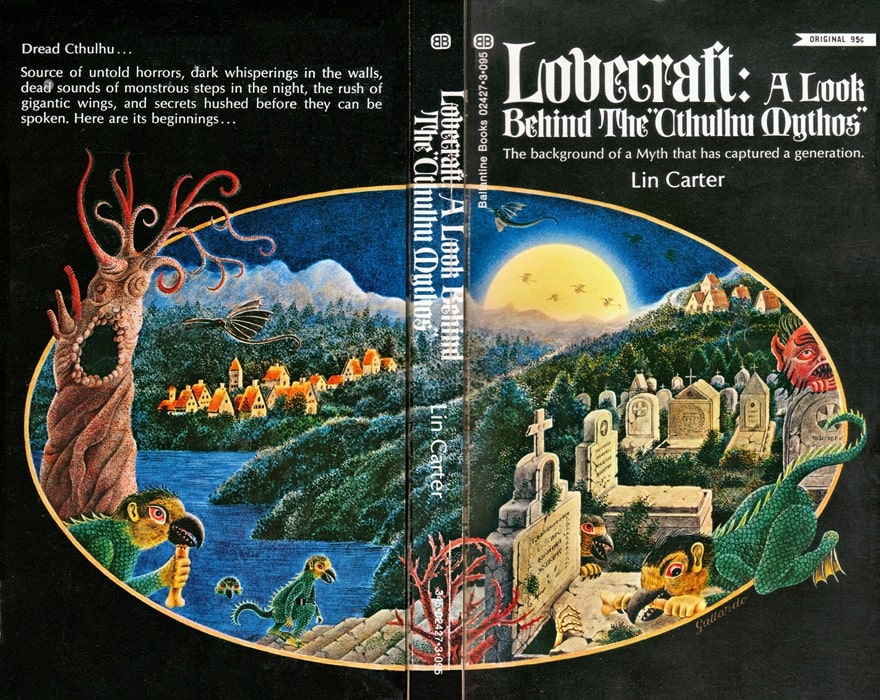
Frazetta sometimes cut corners by blurring feet or even the lower part of a figure. But Jones was really bad about that, as in the Fantastic cover here. There is no good artistic reason for making about 1/3 of the figure’s body a mass of color without definition. Probably Jones charged less if the painting was unfinished in this regard and the editor went along with it. It’s annoying.
I do wonder if an Ace editor got on Jones’s case about the blurred feet thing and Jones got back at the editor with the cover art for The Moon of Gomrath. There you have a warrior emerging from magical flames, and he’s wearing… a ballet slipper.
Good Lord, Rich, you’re making me feel old! I bought that Conan issue of Fantastic new off the shelf at my local drugstore back when George McGovern was still a thing. I don’t know where that copy is now, but it’s likely in better shape than I am.
Rich,
I wish we had more articles like this. It’s a genuine pleasure to read a lively discussion of a magazine from the days when I started reading SF.
It’s not just that tho. Your piece brought me back to an era when magazines were the beating heart of the genre. Not just surprising new fiction from good writers, but the art — from folks who would go on to incredible things, like Jeff Jones, MIke Kaluta, and New X-Men co-creator Dave Cockrum — and especially the non-fiction. I’d totally forgotten that both SF in Dimension and Literary Swordsmen were assembled from columns in Fantastic. And of course the reviews! Covering such exciting new titles, and written by Fritz Leiber, no less.
It reminded me what an event it was to get the new issue of Analog and Asimov’s every month in 1976. How they made me feel connected to a rich and thriving SF community, filled with authors and artists doing amazing things.
I’ve lost that sense of the magic of magazines over the years, but it was that enchanting aspect — the way they were a window to a seemingly limitless realm of adventure, discovery, and large personalities — that made me a fan of magazines for life.
Thanks for rekindling that magic, even if just for 25 minutes or so. 🙂
“sometimes controversial editorials by Ted White”
I enjoyed Ted’s editorials even though I was just a dumb teen at the time, and probably didn’t appreciate all he was saying. I didn’t discover Fantastic and Amazing until 1976, so I missed out on these issues you’re highlighting, but I’m going to look them up as they look pretty cool to me.
On Ted White’s editorials, Ansible Editions recently released collections of Ted White’s editorials from Fantastic and Amazing, each in separate volumes. I got my copies last week and have been slowly going through them. Even though they’re from several decades past, they make for good reading!
The list of interior artists is very familiar to those of us reading Marvel and DC comics at the time: Mike Kaluta drew a number of E. R. Burroughs adaptations for DC, Joe Staton worked on Green Lantern among other books for DC, Billy Graham was on Marvel’s Luke Cage, Hero For Hire and Dave Cockrum drew DC’s Legion Of Super-Heroes before moving to Marvel a few years later and helping restart the X-Men. As for Jeff Jones, he drew a few beautifully moody covers and stories for DC. His trademark mass of dark paint on paperback covers certainly annoyed some but all the paintings of his I’ve seen just work for me, it’s like the figures are still emerging from their creator’s imagination and they’re captured in in the process of creation. And Jones’ courage in being true to his/her own feelings and living a chunk of his/her life as Jeffrey Catherine Jones is something I admire.
Identifying a couple more of the letter writers-
Dennis O’Neil published at least one short story under Ted White, but was much better known as Denny O’Neil. He was a major comic book writer for several decades, and notably revamped both Batman and Green Lantern in the early 1970s.
Maggie Thompson was a major figure in comics fandom and along with her husband, the late Don Thompson, she edited the Buyer’s Guide, a major comics newszine, for many years.
I remember seeing quite a few letters from Lester Boutillier in the White-edited Amazing and Fantastic. I’ve occasionally wondered what became of him and some of the other regular letterhacks.
I’m a huge fan of the work of Clark Ashton Smith, but there’s no denying he can be something of an acquired taste. For a start, you need to to enjoy extremely ornate, colourful prose, and the extensive use of extremely obscure word. Reading Smith can certainly improve your vocabulary!
I loved Mike Hinge’s art; it’s a shame there’s never been a proper collection of his paintings.
The name Dennis O’Neil rang a bell and looking at the ISFDB I see that I read his story “The Killing of Mother Corn” in F&SF in 1975, and I dimly recall thinking it was pretty good. Also, I see that he was from St. Louis, where I live, though I imagine he may have been gone by the time I came.
I read one CA Smith book as a teenager. I do plan to try him again.
I think Fantastic had a great run in this period. I hope to see more of your reviews of Fantastic here at Black Gate.